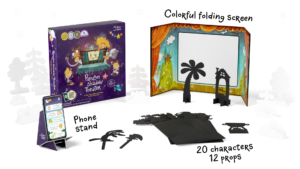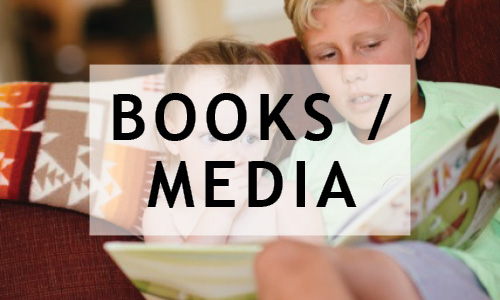 The Papaton Shadow Theater, created by Papaton Kids (Creative Director Anton Ten and Product Director Anna Ten), takes the fun of storytelling to a whole new level. This box features everything you need to put on a Tony-award-winning show for the whole family.
The Papaton Shadow Theater, created by Papaton Kids (Creative Director Anton Ten and Product Director Anna Ten), takes the fun of storytelling to a whole new level. This box features everything you need to put on a Tony-award-winning show for the whole family.
Inside the box is the theater stage that stands alone once folded out. Two envelopes include critical story elements. One envelope contains 20 character cut outs (e.g. three little pigs, wolf, lion, mouse, princess, etc.) and the other has various background settings (houses, trees, castles, etc.). The characters have a convenient holding stick and setting pieces can stand alone so hands are free to manipulate characters. All are made of a heavy duty card stock that withstood multiple stories over many weeks.
Now, let the show begin! First, download the free Papaton Kids app from the App Store. The app features four different fairytales to be read and then retold by kids (and parents!). It also provides the instrumental background music and flashlight from your phone for the shadow characters to come to life.
Next, set your scene. It was terrific to witness our toy tester teams plan a story before the show began. They sifted through trees and houses and planned out the characters and roles. Role assignments and setting was a language task in itself! Kids negotiated which characters to be and planned dialogue.
Cue the intro music and sit back and enjoy the show! Our puppeteers had a blast retelling familiar fairytales and then creating their own! They soon discovered that holding characters closer or further from the shadow screen changes the size appearance to the audience (which was used to their advantage as the wolf in the Three Little Pigs grew angrier).
Why we love it!
Narrative development is an essential skill as a child reaches school age. It includes the ability to tell a cohesive story with sequenced events. As a child grows older, the story becomes more complex with additional story elements (i.e. characters, setting, problem, events, consequences, solution). As children use language to describe a scene or create dialogue, they are building vocabulary skills, exercising creativity and practicing social-emotional skills. Practicing (and improving!) storytelling has also been linked to improved literacy skills.
So children are learning through play! The best and most effective way to play. I love how older children guided younger children with storytelling. Younger children practiced their ability to use dialogue and produce logical and sequenced events as they used language for entertainment. The Papaton Show Theater is fantastic way to build language, vocabulary, and encourage cooperative play.



